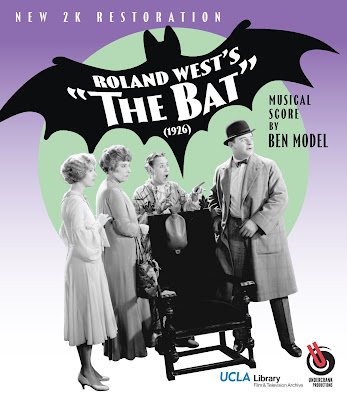Last night's Lon Chaney Double Feature marked the last event of this year's Halloween silent film decathalon. After a dozen shows over the past two weeks, I can relate to Lon Chaney's character in 'The Unknown' (1927), a circus performer with no arms.
Well, even so, I'd better find them as I'm off to San Francisco (and boy are my arms tired!), where on Saturday, Nov. 2, I'll accompany a screening of 'Daughter of the Dawn' (1920) at the Niles Essanay Silent Film Museum.
The showing is part of weekend of programming celebrating National Native American Heritage Month. Also on hand will be Rodney Sauer of the Mont Alto Motion Picture Orchestra, who will accompany the Delores Del Rio drama 'Ramona' (1928) on piano.
A scene from 'Daughter of the Dawn' (1920).I've never done music for 'Daughter of the Dawn' before, and it's a real honor to be asked to score the film at the Niles Essenay museum, one of the premier venues in the nation for what I do. Thanks in advance to Rena Azevedo Kiehn and everyone there for giving me this opportunity!
'Daughter of the Dawn' stands as one of the very few motion pictures made by and for Native Americans during the silent era. It's a trove of authentic practices of the time, and includes rare scenes of traditional tribal dancing.
I'll do my best to do justice to these scenes, which
will be interesting, considering my own personal heritage of native
dance is Polish polkas and Irish step dancing.
Then it's back East, where on Monday night I'll accompany a film about the Old South: Buster Keaton's 'The General' (1926) at the Garden Cinemas in Greenfield, Mass.
Below is a press release with details about the film and the screening. Hope to see you there!
* * *
Buster and his costar in 'The General' (1926).MONDAY, OCT. 28, 2024 / FOR IMMEDIATE RELEASE
Contact: Jeff Rapsis • (603) 236-9237 • jeffrapsis@gmail.com
Buster Keaton's 'The General' with live music at Garden Cinemas on Monday, Nov. 4
Civil War railroading comedy/adventure film lauded as stone-faced comic moviemaker's masterpiece
GREENFIELD, Mass.—
He never smiled on camera, earning him the nickname of "the Great Stone
Face." But Buster Keaton's comedies rocked Hollywood's silent era with
laughter throughout the 1920s.
See for yourself with a screening
of 'The General' (1926), one of Keaton's landmark feature films, on Monday, Nov. 4 at 6:30 p.m.
at the Greenfield Garden Cinemas, 361 Main St., Greenfield, Mass..
The
screening will feature live accompaniment by Jeff Rapsis, a New
Hampshire-based composer who specializes in creating music for silent
films.
Admission is $10.50 adults, $8:50 for children, seniors, and students. Tickets are available online or at the door.
The
show is intended to give area movie-goers the opportunity to experience early cinema as it was
intended: on the big screen, with live music, and with an audience.
'The
General,' set during the U.S. Civil War, tells the story of a southern
locomotive engineer (Keaton) whose engine (named 'The General') is
hijacked by Northern spies with his girlfriend on board.
Keaton,
commandeering another train, races north in pursuit behind enemy lines.
Can he rescue his girl? And can he recapture his locomotive and make it
back to warn of a coming Northern attack?
Critics call 'The
General' Keaton's masterpiece, praising its authentic period detail,
ambitious action and battle sequences, and its overall integration of
story, drama, and comedy.
It's also regarded as one of
Hollywood's great railroad films, with much of the action occurring on
or around moving steam locomotives.
Accompanist Jeff Rapsis will
improvise an original musical score for 'The General' live as the movie
is shown, as was typically done during the silent film era.
"When
the score gets made up on the spot, it creates a special energy that's
an important part of the silent film experience," said Rapsis, who uses a
digital synthesizer to recreate the texture of a full orchestra for the
accompaniment.
"All those elements are important parts of the silent film experience," Rapsis said. "Recreate those conditions, and the classics of early Hollywood leap back to life in ways that can still move audiences today."
Keaton, along with Charlie Chaplin and Harold Lloyd, stands today as one of the silent screen's three great clowns. Some critics regard Keaton as the best of all; Roger Ebert wrote in 2002 that "in an extraordinary period from 1920 to 1929, (Keaton) worked without interruption on a series of films that make him, arguably, the greatest actor-director in the history of the movies."
A remarkable pantomime artist, Keaton naturally used his whole body to communicate emotions from sadness to surprise. And in an era with no post-production special effects, Keaton's acrobatic talents enabled him to perform all his own stunts.
Critics review 'The General':
"The most insistently moving picture ever made, its climax is the most stunning visual event ever arranged for a film comedy."
—Walter Kerr, author of 'The Silent Clowns'
"An almost perfect entertainment!"
—Dave Kehr, Chicago Reader
"What makes the film so special is the way the timing, audacity and elegant choreography of its sight gags, acrobatics, pratfalls and dramatic incidents is matched by Buster's directorial artistry, his acute observational skills working alongside the physical élan and sweet subtlety of his own performance."
—Time Out (London)
The Keaton films are a great introduction to silent films for modern audiences, accompanist Rapsis said.
"Keaton's comedy is as fresh today as it was a hundred years ago — maybe more so, because his kind of visual humor is a lost art," Rapsis said.
‘The General’ (1926) starring Buster Keaton will be shown with live music on Monday, Nov. 4 at 6:30 p.m. at the Greenfield Garden Cinemas, 361 Main St., Greenfield, Mass..
Admission is $10.50 adults, $8:50 for children, seniors, and students.
Tickets available at the door; advance tickets are available at www.gardencinemas.net. For more information, call the box office at (413) 774-4881.



































